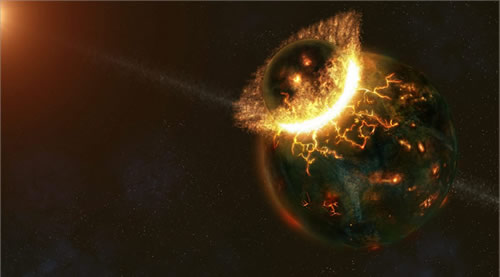Origins of the Moon
9.5 - Understand the Giant Impact Hypothesis and alternative theories of the Moon’s origin, including Capture Theory and Co-accretion TheoryThere are several theories about how the Moon originated:
- Co-accretion: The Moon formed at the same time as Earth in a similar place.
- Capture: The Moon evolved in a different part of the Solar System and was captured by Earth's gravity
- Fission: The Earth spun rapidly during its early evolution and Earth material flung out to form the Moon.
- Giant Impact: A Mars size object crashed into the early Earth, changing its axis and jettisoning debris into its orbit and the Moon formed from this.
Since astronauts visited the Moon in 1969 our understanding about its origins has increased.
Analysis of rock from the Apollo landings confirm the Moon is made of similar material and rock as the Earth from about the same time and have almost identical oxygen isotopes in them .
This eliminates the capture theory and the dynamics about how this could have occurred would be debatable anyway. Accretion does not explain why the moon has a smaller iron core or the angle and elliptical path of the moon's orbit. Fission is unlikely as oceanic crust from where the theory says the Moon came from (the Pacific Ocean) is younger than the Moon. It is also unlikely as the Moon contains more mantle than crust.
The Giant Impact hypothesis is now the more accepted theory of how the Moon formed. When the Earth was still forming it was hit at a a glancing angle by a body approximately the same size as Mars, The Earth was titled and the ejected material formed the Moon, Computer models have shown this was possible and explains the moon's orbit and rotation.
The hypothesis is also known as 'The Big Splash' or 'The Big Whack'.


 | © All Rights Reserved |
| © All Rights Reserved |